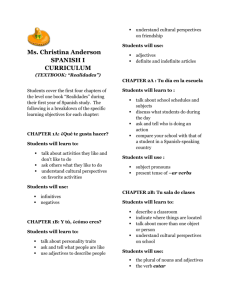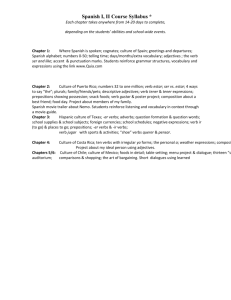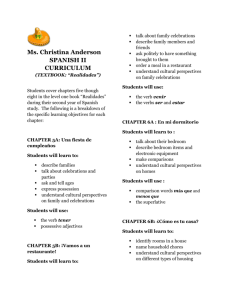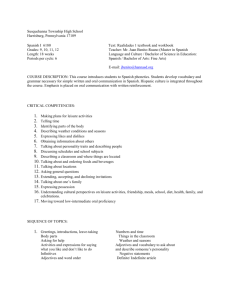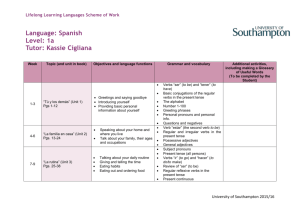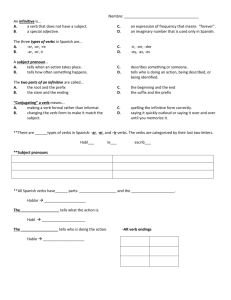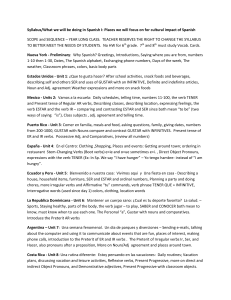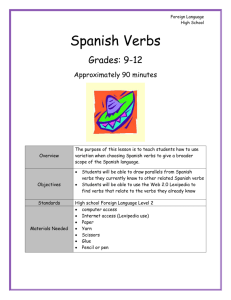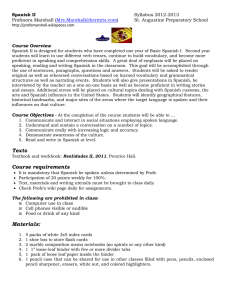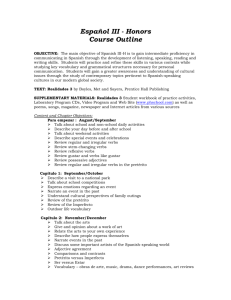Design and Architecture Senior High School 2013
advertisement
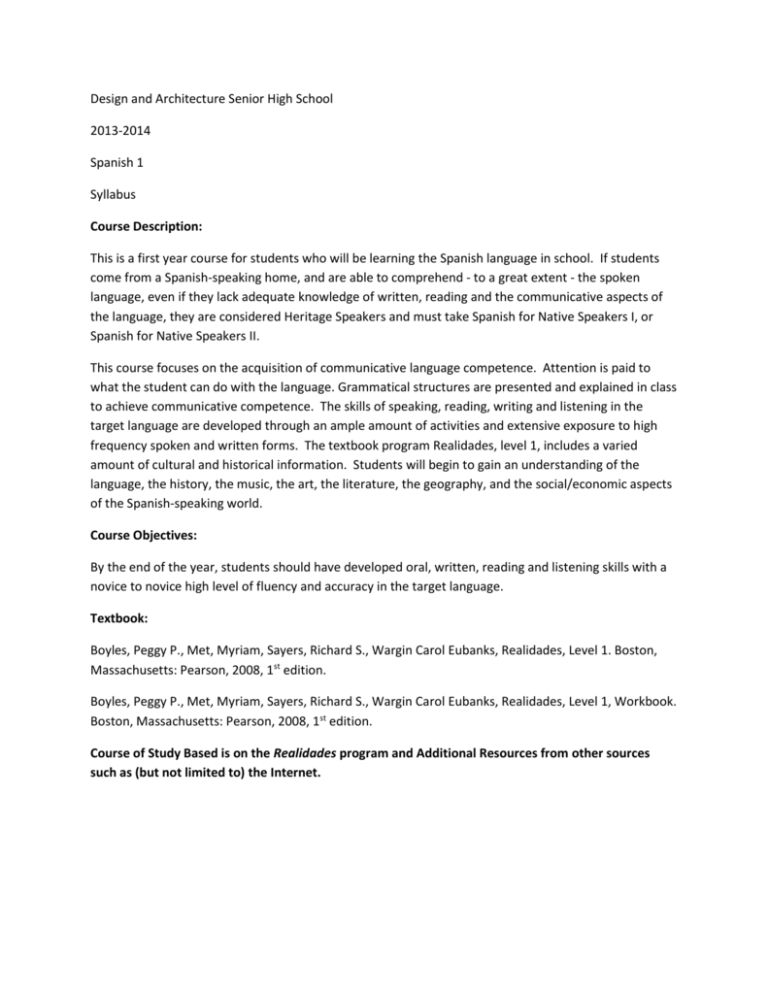
Design and Architecture Senior High School 2013-2014 Spanish 1 Syllabus Course Description: This is a first year course for students who will be learning the Spanish language in school. If students come from a Spanish-speaking home, and are able to comprehend - to a great extent - the spoken language, even if they lack adequate knowledge of written, reading and the communicative aspects of the language, they are considered Heritage Speakers and must take Spanish for Native Speakers I, or Spanish for Native Speakers II. This course focuses on the acquisition of communicative language competence. Attention is paid to what the student can do with the language. Grammatical structures are presented and explained in class to achieve communicative competence. The skills of speaking, reading, writing and listening in the target language are developed through an ample amount of activities and extensive exposure to high frequency spoken and written forms. The textbook program Realidades, level 1, includes a varied amount of cultural and historical information. Students will begin to gain an understanding of the language, the history, the music, the art, the literature, the geography, and the social/economic aspects of the Spanish-speaking world. Course Objectives: By the end of the year, students should have developed oral, written, reading and listening skills with a novice to novice high level of fluency and accuracy in the target language. Textbook: Boyles, Peggy P., Met, Myriam, Sayers, Richard S., Wargin Carol Eubanks, Realidades, Level 1. Boston, Massachusetts: Pearson, 2008, 1st edition. Boyles, Peggy P., Met, Myriam, Sayers, Richard S., Wargin Carol Eubanks, Realidades, Level 1, Workbook. Boston, Massachusetts: Pearson, 2008, 1st edition. Course of Study Based is on the Realidades program and Additional Resources from other sources such as (but not limited to) the Internet. This is a tentative course calendar. Pacing will be modified according to the needs of the class. Month Units of Study/Themes Grammar Culture August/September En la escuela Begin to communicate by using the vocabulary necessary to greet people, referring to different times of the day, respond to classroom directions, using numbers, describing weather conditions, identifying parts of the body. The Spanish alphabet. Infinities, negatives, agreement and disagreement. Learn about the Aztec calendar. Subject pronouns. Present tense of arverbs. The verb “estar”. Plural of nouns and articles. Present tense of –ir and –er verbs. Verbs with unique form: “gustar” and “encantar”. The plural The Hispanic World: Mexico, Central America, South America. Gestures in the Spanishspeaking En la clase El tiempo ¿Qué te gusta hacer? Y tú, ¿cómo eres? October Tu día en la escuela Tu sala de clases ¿Desayuno o almuerzo? Para mantener la salud Connection to other Disciplines Music, Geography, Literature Compare weather in the northern and southern hemispheres. Understand cultural perspectives on favorite activities Understand cultural perspectives Definite and indefinite on friendship. articles. Use The role of descriptive adjectives. Spanish in the business world. Begin to learn about the Hispanic World: Spain and the Caribbean Mathematics, History November/December ¿Adónde vas? ¿Quieres ir conmigo? Una fiesta de cumpleaños ¡Vamos a un restaurante! January En mi dormitorio ¿Cómo es tu casa? of adjectives, and the verb “ser”. world. Understand cultural perspectives on school, meals, diet and health The verb “ir” and asking questions. The immediate future construction. The verb “jugar”. The verb “tener”. Possessive adjectives. The verb “venir” . The verbs “ser” and “estar” Understand cultural perspectives on leisure activities, after-school activities, family and celebrations. The Hispanic World: The role of Spanish in the USA, in the world, in the community, in the business world. Mathematics, History, Art Making comparisons. The superlative. Stemchanging verbs: poder and dormir. Affirtmative “tú” commands. The present progressive tense. Understand the cultural perspectives on homes, different types of housing. Social Studies, Mathematics February/March ¿Cuánto cuesta? ¡Qué regalo! De vacaciones April/May Ayudando en la comunidad. El cine y la televisión La tecnología June Review/finish all covered/required chapters. Stem-changing verbs: “pensar”, “querer”, and “preferir”. Demonstrative adjectives. The preterit of –ar, -er, and -ir verbs. Verbs ending in –car, and – gar. Direct object pronouns. Preterit of “ir”, the personal “a”. Understand the cultural perspectives on shopping, gift-giving, travel and vacation. Mathematics, History, Geography The present tense of “decir”, indirect object pronouns, present of “hacer” and “dar”. “Acabar de + infinitive”. “Gustar” and similar verbs. The present tense of “pedir” and “servir”, “saber” and “conocer”. Understand cultural perspectives volunteer work, common gestures, using technology Mathematics, Technology
